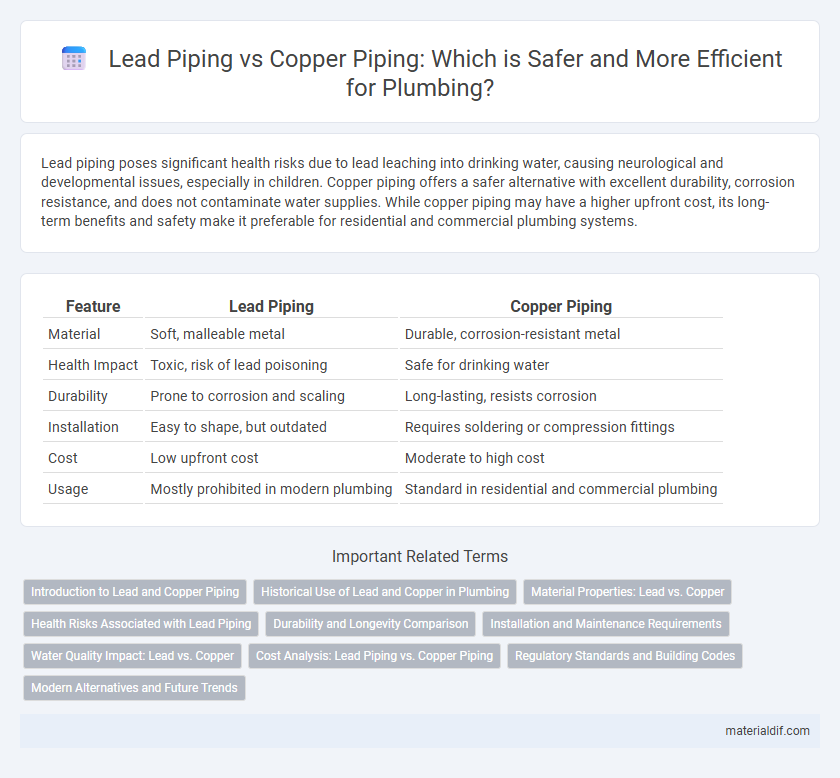Lead piping poses significant health risks due to lead leaching into drinking water, causing neurological and developmental issues, especially in children. Copper piping offers a safer alternative with excellent durability, corrosion resistance, and does not contaminate water supplies. While copper piping may have a higher upfront cost, its long-term benefits and safety make it preferable for residential and commercial plumbing systems.
Table of Comparison
| Feature | Lead Piping | Copper Piping |
|---|---|---|
| Material | Soft, malleable metal | Durable, corrosion-resistant metal |
| Health Impact | Toxic, risk of lead poisoning | Safe for drinking water |
| Durability | Prone to corrosion and scaling | Long-lasting, resists corrosion |
| Installation | Easy to shape, but outdated | Requires soldering or compression fittings |
| Cost | Low upfront cost | Moderate to high cost |
| Usage | Mostly prohibited in modern plumbing | Standard in residential and commercial plumbing |
Introduction to Lead and Copper Piping
Lead piping, historically used for water distribution due to its malleability and durability, poses significant health risks because lead can leach into drinking water and cause poisoning. Copper piping, widely adopted as a safer alternative, offers corrosion resistance, longevity, and does not contaminate water with harmful substances. Understanding the distinct properties, health impacts, and regulatory standards of lead and copper piping is crucial for ensuring safe and sustainable plumbing systems.
Historical Use of Lead and Copper in Plumbing
Lead piping was widely used in ancient Rome and early modern plumbing systems for its malleability and resistance to corrosion despite its toxicity. Copper piping gained popularity in the 20th century due to its durability, corrosion resistance, and safety for potable water systems. The transition from lead to copper marked a significant advancement in plumbing standards driven by growing health concerns associated with lead exposure.
Material Properties: Lead vs. Copper
Lead piping exhibits high malleability and corrosion resistance but poses significant health risks due to lead leaching. Copper piping offers superior durability, antimicrobial properties, and resistance to biofilm formation, making it safer for potable water systems. Copper's higher tensile strength and thermal conductivity also enhance its performance in plumbing applications compared to lead.
Health Risks Associated with Lead Piping
Lead piping poses significant health risks due to the potential leaching of lead into drinking water, which can cause neurological damage, especially in children and pregnant women. Copper piping, while generally safer, may still release copper ions in acidic water but lacks the severe toxicity associated with lead. Regulatory agencies like the EPA have established strict limits on lead levels in water to minimize exposure and protect public health.
Durability and Longevity Comparison
Lead piping exhibits significant corrosion issues and tends to deteriorate faster, often lasting around 50-75 years under optimal conditions. Copper piping demonstrates superior durability, with an average lifespan of 70-100 years, due to its resistance to corrosion and microbial buildup. The longevity of copper pipes contributes to lower maintenance costs and reduced risk of contamination compared to lead pipes.
Installation and Maintenance Requirements
Lead piping requires cautious handling during installation due to toxicity risks, necessitating specialized protective measures and compliance with strict health regulations. Copper piping offers easier installation with standard tools and less health hazard, promoting faster project completion and lower labor costs. Maintenance for lead pipes includes regular monitoring for corrosion and potential contamination, whereas copper piping demands periodic inspection to prevent oxidation and leaks.
Water Quality Impact: Lead vs. Copper
Lead piping significantly deteriorates water quality by leaching toxic lead particles into drinking water, posing severe health risks such as neurological damage and developmental issues. Copper piping, in contrast, is more inert and does not release harmful contaminants, maintaining safer and cleaner water quality. Regulatory agencies often recommend replacing lead pipes with copper to ensure compliance with health standards and reduce lead exposure.
Cost Analysis: Lead Piping vs. Copper Piping
Lead piping typically incurs lower initial material costs compared to copper piping, making it a budget-friendly option for short-term projects. However, copper piping offers superior durability and lower maintenance expenses, resulting in a more cost-effective solution over time. The cumulative price of lead pipe replacement and health-related liabilities often surpasses the upfront savings of lead, positioning copper as a financially prudent choice in long-term plumbing investments.
Regulatory Standards and Building Codes
Lead piping is largely banned under current regulatory standards such as the Safe Drinking Water Act (SDWA) in the United States due to its toxicity and risk of lead contamination, with most building codes mandating the use of copper or approved alternatives for potable water systems. Copper piping complies with standards set by organizations like NSF International and the American Society for Testing and Materials (ASTM), ensuring safety and durability in residential and commercial plumbing. Building codes such as the International Plumbing Code (IPC) and Uniform Plumbing Code (UPC) specify copper as a preferred material, reflecting strict regulations against lead piping to protect public health.
Modern Alternatives and Future Trends
Modern alternatives to lead piping include copper and cross-linked polyethylene (PEX) pipes, which offer superior durability and corrosion resistance. Copper piping remains popular due to its longevity and antibacterial properties, while PEX piping provides flexibility, easier installation, and cost efficiency. Future trends emphasize sustainable materials such as recycled plastics and advanced composite pipes designed to enhance water safety and reduce environmental impact.
Lead piping vs Copper piping Infographic

 materialdif.com
materialdif.com